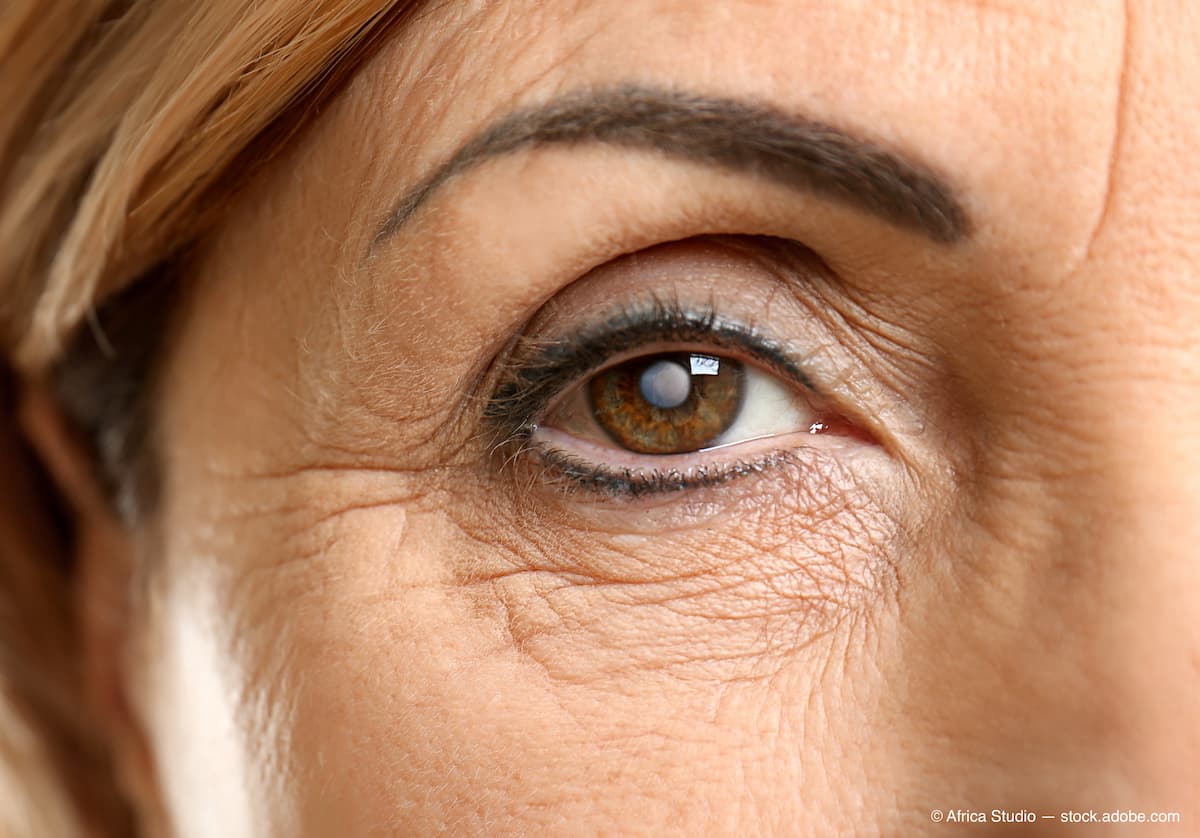Presbyopia and cataracts: Dysfunctional lens syndrome
Even if DLS is completely normal and expected, it can be mentally and emotionally difficult for patients.
(Adobe Stock / Africa Studio)

The crystalline lens is a very important structure within our eyes, helping to focus light onto the retina. For the lens to perform this function, it needs to remain optically transparent and be flexible, allowing for changes of the curvature to adjust the focal distance. With aging, the transparency and flexibility become impaired, leading to presbyopia and cataracts.1 These 2 disease states together have come to be known as dysfunctional lens syndrome.
Prevalence
If they live long enough, everyone will eventually develop cataracts and presbyopia. In 2022, the total cases of presbyopia were approximately 123 million in the United States with a prevalence of 83.0% to 88.9% in adults 45 years or older.2 Of the estimated 1.8 billion presbyopia cases worldwide, 826 million cases have no or inadequate vision correction.3 That’s 45% of people with presbyopia with a need for correction or better treatment for something that we as eye care physicians know can be easily treated. Approximately 95 million people worldwide have moderate to severe vision impairment related to untreated cataracts.4 Between these 2 disease states, a significant number of people are untreated or undertreated at different stages of dysfunctional lens syndrome (DLS).
Disease burden
For patients with uncorrected or under corrected DLS, loss of visual function can carry a significant burden emotionally and economically. Multiple studies have shown decreased quality-of-life scores in patients with both presbyopia and cataracts.2 Difficulty performing routine tasks up close can increase distress and decrease self-esteem.2 Another study found that poor visual acuity, decreased contrast sensitivity, and decreased visual field were all risk factors in patients reporting 2 or more falls within a 12-month time period.4
A study released in 2023 found that patients with cataracts, especially men, were more likely to develop major depressive disorder than those without cataracts.5 Investigators theorized that because there are gender-related differences in reactivity to negative conditions, this may contribute to the higher odds in men.5 The study investigators say higher levels of major depressive disorder in cataract patients is likely related to worsening vision leading to worsening socioeconomic status and employment.5 Unemployment can be associated with a loss of identity, leading to feelings of despair and depression.5
The productivity loss in working-age presbyopic patients has been studied extensively. It is estimated that across 244 million patients younger than 50 years, uncorrected and under corrected, presbyopia resulted in productivity losses of US $11.0 billion.2
Dysfunctional Lens Syndrome
With aging, the crystalline lens increases in stiffness and thickness, causing the vector forces from the zonules to be spread over a wider region around the equator.6 This leads to a decreased effect on the lens shape with zonular contraction and relaxation, decreasing accommodative function.6 These accommodative changes are accompanied by yellowing of the lens and decreasing pupil size. Together they create DLS, a term proposed in 2005 to describe the continued changes in the crystalline lens related to aging.7
Stages of DLS
» Stage 1: Stiffening of crystalline lens with associated loss of focusing power and difficulty with near vision. Aged 40 to 50 years.
» Stage 2: Continued lenticular changes leading to loss of accommodation, decreased contrast sensitivity, and difficulty with night vision due to light scatter within the lens. Aged 50 years and up.
» Stage 3: Significant yellowing and opacification of the lens with degraded vision and altered color perception. Aged 65 years and up.
Treatments
The Wold Health Assembly has defined cataracts and refractive error as avoidable causes of vision impairment because they can be effectively treated.4 A large number of patients go untreated or undertreated for all stages of DLS despite the availability of multiple treatment options for all stages of DLS.
» Glasses
• Computer glasses
• Bifocal glasses
• Progressive glasses
» Contact lenses
• Monovision contact lenses
• Multifocal contact lenses
» Refractive lens exchange/cataract surgery
• Extended depth-of-focus lenses
• Trifocal lenses
• Enhanced monofocal lenses
• Pinhole aperture
• Light adjustable lenses
» Presbyopia-correcting eye drops
• Pilocarpine-based
• Carbachol
• Aceclidine
• Brimonidine

Regardless of the type or number of treatments, it is important to help our patients with dysfunctional lens syndrome. Even if DLS is completely normal and expected, it can be mentally and emotionally difficult for patients. Discuss the journey with your patients and help guide them through.
References
1. Petrash JM. Aging and age-related diseases of the ocular lens and vitreous body. Invest Ophthalmol Vis Sci. 2013;54(14):ORSF54-ORSF59. doi:10.1167/iovs.13-12940
2. Berdahl J, Bala C, Dhariwal M, Lemp-Hull J, Thakker D, Jawla S. Patient and economic burden of presbyopia: a systematic literature review. Clin Ophthalmol. 2020;14:3439-3450. doi:10.2147/OPTH.S269597
3. Fricke TR, Tahhan N, Resnikoff S, et al. Global prevalence of presbyopia and vision impairment from uncorrected presbyopia: systematic review, meta-analysis, and modelling. Ophthalmology. 2018;125(10):1492-1499. doi:10.1016/j.ophtha.2018.04.013
4. GBD 2019 Blindness and Vision Impairment Collaborators; Vision Loss Expert Group of the Global Burden of Disease Study. Causes of blindness and vision impairment in 2020 and trends over 30 years, and prevalence of avoidable blindness in relation to VISION 2020: the Right to Sight: an analysis for the Global Burden of Disease Study. Lancet Glob Health. 2021;9(2):e144-e160. doi:10.1016/S2214-109X(20)30489-7
5. Kang MJ, Do KY, Park N, Kang MW, Jeong KS. The risk of major depressive disorder due to cataracts among the Korean elderly population: results from the Korea National Health and Nutrition Examination Survey (KNHANES) in 2016 and 2018. Int J Environ Res Public Health. 2023;20(2):1547. doi:10.3390/ijerph20021547
6. Singh P, Tripathy K. Presbyopia. In: StatPearls. StatPearls Publishing; 2023.
7. Waring GO, Rocha KM. Characterization of the dysfunctional lens syndrome and a review of the literature. Curr Ophthalmol Rep. 2018;6:249-255.

Newsletter
Want more insights like this? Subscribe to Optometry Times and get clinical pearls and practice tips delivered straight to your inbox.